In a lot of ways, Ashes series are like birthdays. Not in the sense of coming around twice every four years, and not in the sense of taking eight weeks to wrap them up. But in the sense of marking personal eras. In the sense of bringing people together. In the sense of making you stay up until stupid hours when you really have important things to do tomorrow. And in the sense that they have such anticipation and build-up that there is always the risk of a let-down.
If we’re honest, a lot of Ashes editions are not intrinsically interesting. They’re interesting for the hype and the context and the history, but when the cricket itself has one struggling team, the other quickly exerts its primacy. Within a couple of days you have a good idea of which is dominant. That side duly asserts itself, but takes its own sweet time about it. When you already know who’s going to win, a match that goes for five days can take a very long time. A series that goes for five Tests can take a whole lot longer.
In the English summer of 2019, though, we had two struggling teams. Or to be more accurate, two teams that hadn’t even been together long enough to know whether they were going to struggle, both cobbled together out of recycled bits and pieces like the cricket equivalent of Bush Mechanics. To be more accurate still, we had two struggling batting line-ups and two excellent bowling line-ups, which meant the batting line-ups would struggle even further. Since cricket is a sport entirely split into two parts, the disparity can be immense. It’s akin to having a lot of shit pheasants and a lot of good shooters.
It is one of the peculiarities of Test cricket that so many players can be picked for it without appearing even slightly suited for the task. It’s rare that you look at a player at a football World Cup and think, “That person has no idea how to play football.” They might not be as fast or as smooth or as good as the stars, but they can fundamentally run to the right place, attempt a tackle, hoof a ball upfield. Even at a Cricket World Cup, the bit-part all-rounders largely look like they could bowl six overs at a run a ball, or whack a quick 30. In a Test match, though, you get a handful of players who really look like they belong there, and you get the rest looking like they’ve been mugged of the faintest fucking clue.
Two struggling batting line-ups and two excellent bowling line-ups… It’s akin to having a lot of shit pheasants and a lot of good shooters.
Some fans of a sport will claim that they only want the best of the best, usually while trashing another version of the sport that they deem inferior. But it’s not really true. When great Australian sides demolished teams like in the Ashes of 2001, it… really wasn’t very interesting. The quality of play was excellent but the contest was non-existent. The tension was a gentle mist.
This, then, was what made 2019 so good: a retreat into the glory of mediocrity. Because both teams were very ordinary, both struggled equally. Because no team could bat through a day, no score was ever safe. Because nothing was solid, games moved fast in fluid twists and swirls. With batsmen struggling so hard, the successes that they did manage had a much bigger influence. And when moments of true quality did emerge, they shone far brighter in the gloom.
Before the series, it was supposed to be advantage England. The custom batch of Dukes balls, ordered to the specifications of the previous season against India, when they had hooped so consistently that swingmaster Jimmy Anderson had left his keys in the bowl all summer long. The home conditions. The squad enthusiasm and national cheer of a World Cup win. The learning experience of being bowled out by Ireland for 85 in a Test at Lord’s. Okay, less so the last one.
For Australia, their two best batsmen were coming back after 16 months out of Test cricket. Steve Smith and David Warner had 44 Test hundreds between them and their absence had been keenly felt since the day they were suspended in March 2018. But nobody had any idea how they would go. The time away, the rust, the humiliation of having been caught cheating and punished all in front of a loud worldwide audience. They were a flip of a coin as to whether their comebacks would be success or failure.
Warner, Cameron Bancroft, Usman Khawaja, Smith, Travis Head, Matthew Wade, Tim Paine. Sitting in reserve, Mitchell Marsh, Marcus Harris and Marnus Labuschagne. Australia held the Ashes, but there was little question that this list of batsmen would lose matches somewhere along the way. Australia needed wins, from somewhere.

Wins, of course, need bowlers. You need twenty wickets, unless you can dupe them into declaring while you still have cards up your sleeve. On the first day at Edgbaston, two things became clear:
- Jimmy Anderson was not going to have a big influence on the series.
- Steve Smith was.
The two were ships in the night. Anderson had been carefully managed in the lead-up, skipped the Ireland Test to stay fit, played some gentle domestic cricket to ease into his workload, then tweaked a calf strain inside half an hour on the first morning. Four overs, three maidens, one run conceded. Three balls later, Stuart Broad took a second wicket and brought Smith to the crease. It was as close as he and Anderson would come to facing off.
Smith’s two other sandpaper comrades were the batsmen already out. Warner had been worked over by Broad in the space of nine balls: edging behind but dodging a review, having an lbw review narrowly struck down, then being hit again by one he should have reviewed. Bancroft was caught at slip.

One day. That’s all it took to see this reaction again.
The junior batsman had been shoehorned into the side, meaning all three could return together. Media-wise, this made it easier to argue that a line was now drawn under the subject, and some prickly responses to later questions indicated that the Australian camp expected their interpretation to be agreed to.
For the time being though, Smith was out there alone. Just as it had so often been before his ban. He watched partners come and go: Khawaja for 13, Head for 35, Wade on his own comeback to the side for 1, Paine for 5. Then into the bowlers: James Pattinson for 0, Pat Cummins for 5. The score was 122 with eight wickets down, and the last specialist batsman remaining had 42.
That was the moment when Steve Smith began doing things that Steve Smith should not have been able to do. Bear in mind this is not the same as saying that Steve Smith did things that normal people are not able to do. Steve Smith has always done things that normal people can’t do. This was Steve Smith doing things that even Steve Smith shouldn’t have been capable of.
Firstly, anyone spending over a year out of the game is supposed to need time when returning. Usually we talk of players being rusty after a couple of weeks.
Secondly, Smith’s batting technique is such a finely wrought thing that time out of the game seemed more likely to affect him than anyone. Throw out one tiny bit of that organised mess of moving parts, and surely the whole thing would fail, right? The hand-eye coordination that saves him from being dismissed by all the thousands of balls aimed at his pads should have taken some time to recalibrate.
Thirdly, there was the emotional side. The rawness of public chastisement and personal shame, of abuse and encouragement probably as hard to take as one another. There was the fear of failure, the pressure to prove a point. There was the loud and endless barracking over the fence from England fans. This wasn’t having a lot on his plate, this was having a delivery truck backing up.
Smith should have been the one getting the cushy ride, being eased back into the top level of the game by supportive teammates. Instead he was tasked as the rescue force.
The ball was doing plenty on that first day. Anderson might have been gone but Broad and Chris Woakes were swerving it beautifully. While wickets fell at the other end, Smith waited out the wider lines, and stepped across to smother those close to his stumps. When the ball came at him, he calmly knocked away singles.

Peter Siddle put his hand up to stay with Smith for a while, so Smith just kept batting, scoring in equal measure across an 88-run partnership and moving his own score on to 85 before the Victorian was finally out. Then with Nathan Lyon as his last partner, Smith suddenly changed range, blazing his way to 144 regardless of fielders back on the ropes.
Every part of it was stunning. The skill, the control, the audacity. The ability to push aside every block, cast off every impediment, and stage not just a fightback, score not just a hundred, but probably his best hundred; in terms of technique, in terms of situation, in terms of effect.
But it didn’t end there. After he got Australia to 284, then England rode their luck to 374, Smith just up and did it again. England’s lead of 90 should have been enough, and Australia were three wickets down while still in deficit. Against any other batsman been it would have been England’s to win. Instead, a big Australian lead looked inevitable, because Smith.
The same again. Collecting runs with careful deliberation from the quicks, while whacking Moeen Ali so decisively that the off-spinner was dropped from the series, took an indefinite break from first-class cricket, and may yet have played his last Test. On again, blunting the bowlers, until Wade and his lower order could come in for carnival hour. A lead of nearly 400, and a last-day pitch for Lyon to spin England out.

Smith coming good in the way he did in Birmingham was a Hail Mary. The thing Australia had got completely right though was their fast bowling. After so many years of false dawns and revised dates, physio benches and MRIs, back scans and net bans, exercise bikes and rehab programs, so many mornings of AAP copy about the latest injury setback, the quartet of fast bowling that had been promised for so long was together. James Pattinson, Pat Cummins, Josh Hazlewood, Mitchell Starc.
Right-arm outswing at top speed. Right-arm menace off a length that could seam. Right-arm steepling metronome with the capacity to jag. Left-arm inswing with the new ball and reverse with the old. All of them with the capacity to approach 150 kilometres an hour, three of them able to beat it.
But only three quicks could play. Care had to be taken in which three. Starc was a bit jaded after the World Cup, where he had grabbed 26 wickets but gone off the boil towards the end. Hazlewood hadn’t bowled well in Australia’s warm-up. Pattinson was preferred to come back, but given his injury history Australia needed a banker alongside him, someone to control the innings with long spells.
Siddle: an elder statesman in fast-bowling terms, extremely accurate, and with a million wickets for Essex in the previous two seasons of county cricket. He first saved the Test alongside Smith with the bat, then bowled 39 overs which conceded 80. Lyon’s six wickets on the last day showed the need for spin, while Cummins took the other four, three bounced out in a display of sustained intimidation and one pitched up to take the stumps off the seam in a piece of fast-bowling perfection.
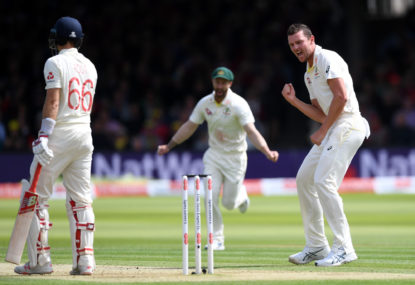
Josh Hazlewood wasted no time in reminding England – and Australian fans – of his quality.
Pattinson did his job as a surprise weapon, then was rotated out as an injury precaution for the second Test. With another warm-up match under his belt, Hazlewood came in for Lord’s and sizzled immediately, knocking over England’s first three batsmen on the way to rolling them for 258.
But if the Australians were excited about their express bowlers finally putting wheels to the rail, England were beyond excited about Jofra Archer. The Barbadian-English fast bowler had come in to replace Anderson. He had only started playing international cricket a couple of months earlier, and had bowled the Super Over that won England a World Cup.
Nothing seemed to faze him. He was lithe of limb and languid of action, seeming to flow to the crease off a few short steps before firing down balls at over 150 kilometres per hour with a fast arm and a high straight action. He glided around the field, standing as nonchalantly at mid-off as he might by a sunny stream. He sometimes wore chunky glittering watches, or chains, or his cricket sweater tied by the arms around his waist. He changed his hairstyle by the match. He smiled fleetingly but surely, and spoke with a soft confidence.
He was, in short, cool. Which means you can forgive England for getting excited about Archer, because England had never had a cricketer who was cool. For a century the closest it came was haughtily stylish exponents of noblesse oblige, playing in their time off from running the East India Company. Even the vaguely dashing ones were schoolmasters or died in various wars. Laddish swashbucklers like Ian Botham and Freddie Flintoff came closest, but young Botham inspired The Office’s insufferable lead character David Brent and has since matured into a kind of gently sweating chunk of Brexit left in the dashboard sun. Flintoff the television presenter is now at least half Jersey Shore.
You can forgive England for getting excited about Archer, because England had never had a cricketer who was cool.
Archer was something else. Shrug his shoulders, lace up his boots, win a World Cup kind of quiet. At Lord’s he had to wait until the fourth day to show what he could do, with two of the first three mostly lost to rain. Then with the clouds scudding and the air clear, he announced himself to Test cricket. Where he seemed to let most of the world glide by, suddenly he was locked in a struggle with Smith. Australia’s batsmen were crumbling around him again.
The spell will be recounted over and over. Like Wahab Riaz to Shane Watson in 2015, the bowler never ended up with the batsman’s wicket. But the scorecard won’t tell you what it was like to watch, as the speed gun cranked up past the Marty McFly range of 88 miles an hour, past 90, up to 95 and 96. It won’t tell you how the crowd gasped and twitched with each short ball that sizzled through the air into the keeper’s gloves.
It won’t tell you how the wind changed, and the clouds came over, and the temperature dropped about ten degrees as the spell began. It won’t tell you how Smith started taking on the bouncer, hooking away outrageously to take the fight to the bowler. It won’t tell of the guttural cheer when he was hit on the arm, then the frightened silence when he was hit on the neck and face-planted in the turf.
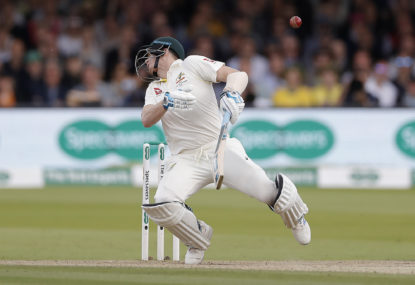
The scariest moment of the series. It won’t show up in the scorecards though.
Smith had looked a lock for his third century in a row, but was forced from the field on 80 and returned to be dismissed for 92, looking concussed in his batting long before the medical tests divined the same result. Without him, Australia were bowled out for 250, eight runs behind England.
But in this crazy fast-forward match, England looked on course to lose by the end of the fourth day. Cummins bowling with venomous pace of his own forced a catch from opener Jason Roy, then produced one of the best balls of his career to scream into Paine’s gloves after taking Root’s edge. It was the England captain’s first ever golden duck.
From two down with nine on the board, England started the fifth day in real danger of being bowled out and leaving a token run chase. Instead, having first battled through to lunch and relative safety, Ben Stokes opened his shoulders and clattered a fast hundred with Jonny Bairstow riding shotgun.
It allowed Root to declare and have a free shot at Australia, no chance of chasing 266 in 48 overs on an erratic pitch, but a fair chance of being bowled out. Smith took no part, and Marnus Labuschagne became Test cricket’s inaugural concussion substitute. He was the one to save the day as Australia slumped to six wickets down with most of the specialist batsmen failing again. They avoided defeat, but that last day for Stokes was just a warm-up for what was to come.

Whenever this match is spoken about for its joyous, riotous, bonkers last day, it will be a bit like skipping to the part in The Lord of the Rings with the volcano and the big armies. Absolutely: Stokes dreamed the impossible dream, won the impossible fight. Scoring 74 with the No. 11 batsman for company to win is a great story however you came to it. But the road to this point has so many tales along its way.
The first day alone, when England won the toss and immediately put Australia in under leaden skies with the ball not so much talking as delivering a dramatic monologue. Broad, the rejuvenated veteran with his shortened run-up and his rejigged release, with the spring back in his step and back in his wrist, a bowler who was supposed to be in his farewell summer but was giving every indication of planning to stick around a while longer. Then Archer, the young man who could have been so carried away with the response to his 95-mile-an-hour short bowling, but instead read the conditions and took wickets with 88-mile-an-hour full deliveries.
Then there was Warner, after four scores in single figures, taking a working-over like few he had experienced. With the ball moving in all directions, he stayed calm, covered his off stump, and hoped that anything swinging or jagging would be doing too much to take his edge. It worked, and after two fast wickets at the other end, Labuschagne found a method to stay with him.
They had a century stand, almost absurd in an innings that totalled 179. For as soon as Archer finally found more subtle movement to produce an unplayable ball and get Warner for 61, the rest followed swiftly. Smith was sitting the match out with concussion, but even he might have struggled here.

David Warner made 95 Ashes runs in 2019. 61 came in a single innings.
That 179 looked skinny, but in good bowling conditions it was still worth something. More than something, as it turned out, with the second morning even more extraordinary than the first.
Australia’s bowlers had been shuffled again, Pattinson back for Siddle. Three quicks with pace to burn and movement at their disposal. Still, they weren’t unplayable. Normally when teams are bowled out for tiny scores, a lot happens in a rush. One bowler gets on a tear, three wickets fall in an over, a couple are out first ball, something to detonate an avalanche. When England were bowled out for 67, you didn’t realise it was going to be that bad until it was almost done.
Most of the wickets had a few overs between them. Most of the batsmen faced a decent handful of deliveries. And yet every ten or fifteen minutes, through the morning and the early afternoon, another catch would be skewed to another fielder with the score having barely moved. Joe Denly spent an hour and a quarter out there for 12 runs. He was the only one who made double figures.
You can imagine how it was received by the local press. Root, who shows an admirable dedication to comedy stylings by wearing the number 66, had his shirt pictured on one back page next to a large 67. Surely England had conceded the Ashes with a display every bit as abject as Australia’s 60 all out at Trent Bridge in 2015.
Except their bowlers hadn’t conceded yet. Australia started the third innings with freedom to swing, leading by 112. But Broad resumed normal service by trapping Warner for a duck, then Woakes and spinner Jack Leach each got a wicket. Finally it was Stokes, powering through 15 overs straight, all in the mid-140 kilometres range for speed, swinging his yorkers late, bowling bouncers, and eventually barging through the defences of Head, then Wade, then Cummins.
Even bowling Australia out for 246, a total run chase of 359 was impossible for a team that had scored about one-fifth of that in its first innings. Nine teams in history had ever scored more than that to win a Test. And both openers fell in the twinkling of an eye, as per usual. Come off it.
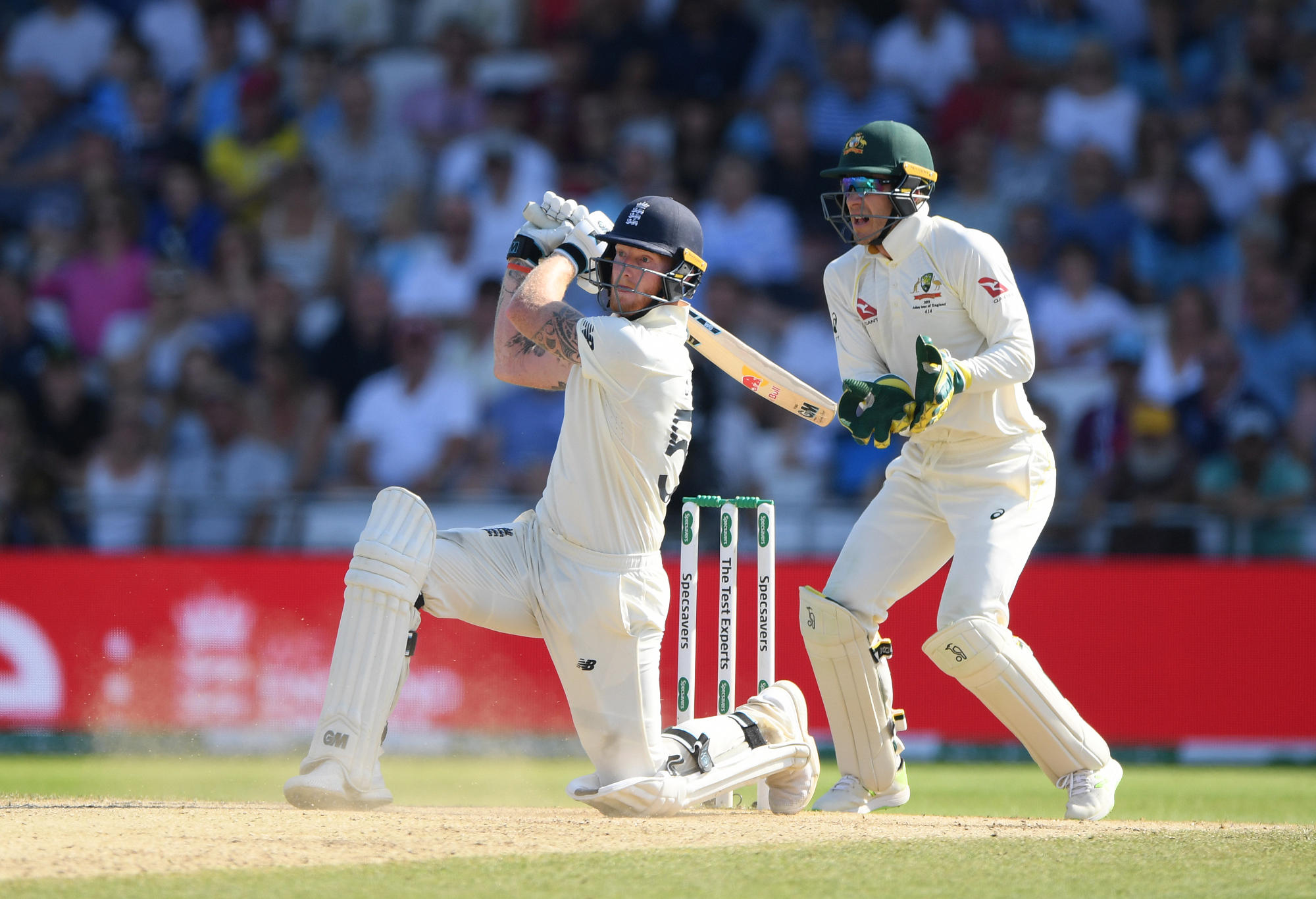
But Root made his best score of the series with 77, and Denly rode his luck for 50, and when Stokes and Bairstow faced the second new ball on the fifth morning, they took it on rather than backing down. The runs flowed more quickly, and even though Bairstow fell for 36, still over a hundred adrift from the target, the idea was lit within Stokes that this might not be impossible after all.
And so the whole perception of the rest of the match changed. Had Australia’s bowlers finished the job, you could fairly say that Warner’s first-day fight had secured them the Ashes. Instead his one excellent performance is lost in his horror run that surrounded it. Had Root conceded the Ashes off the back of that innings, the pressure on his captaincy would be far greater, and the mark on his legacy far less flattering.
There could be whole books written about that one afternoon: the absurdity, the audacity, the euphoria. The sustained clinical violence of his six-hitting, with the last man Leach at the other end. Australia’s bowlers were completely taken aback. Their captain too. They didn’t have a plan for this. They had never needed a plan for this. Everyone ringed the fence, but Stokes just kept going over them. Australia’s DRS referrals were wrong, umpiring decisions were wrong, ball-tracking software was wrong. The catches dropped, the run-outs missed. Everyone was scrambled except for one man with the bat who was clear as a diamond.
In the space of seven overs, the impossible became fact. The series was still alive.

If Headingley had been all about Stokes, it had also borne the shadow of Smith by his absence. In the fourth match, he defined it with his presence. Australia as a team was all Smith, all the time. The openers failed again, with Broad consigning Warner to his first pair of ducks in a Test. Bancroft had already been dropped in Leeds for sticking around without scoring runs; his replacement Harris was scoring just as few but without the sticking around part.
So Smith did it all again, this time with support from Mini-Me Labuschagne, and later from Paine to pile up 497. A double hundred across a couple of days topped off Smith’s series, again grinding down England’s bowlers to the point that his tailenders could come in and tee off. He might have added a fourth series ton for himself in the second innings if he hadn’t been batting for the declaration and hitting out on 82.
This result was for the bowlers who had worked harder for it than anyone.
Either side of Smith’s efforts came the finest hours for Cummins and Hazlewood. This, more than any match, was when their consistent quality told. The track was good for batting, and almost everyone got starts. But the way they landed the ball in just the danger spot again and again, Hazlewood jagging it into the right-handers off the seam, Cummins moving it both ways while also reserving the threat of the short ball, was outstanding.
Mitchell Starc made his own contributions to back them up, in his first Test for the series with Pattinson rested again. It took 107 overs to work through England for 301 by the fourth morning, then the bowlers were back to work a few hours later looking for the win. It came at the expense of another 91 overs, late on the fifth day, with the gloom gathering and bad light threatening an abandonment. For a time it seemed England might escape again, with Leach facing 51 balls and Craig Overton 105.
Eventually the breakthrough came, courtesy of Labuschagne’s golden arm, and Hazlewood fittingly took the final wicket. After their own disaster at Headingley, you could have understood if this Australian team had gone off the rails. But fears were allayed, Smith had been Smith again, and this result was for the bowlers who had worked harder for it than anyone.

It’s one of the weird bits about cricket that retaining a trophy is a different thing to winning a series. If you don’t hold a trophy then you can win it, but if you do hold it then you can only win the series. Retaining does happen occasionally elsewhere, like the Bledisloe Cup. But in most sports (including rugby) drawn matches are rare, and in sports with lots of draws (like football) teams don’t tend to play series of matches against one opponent.
Australia had retained the Ashes in Manchester and had celebrated accordingly. But with only three days before the fifth Test, they showed up in London accordingly dusty. The series wasn’t won, but the technicality aim had been achieved. It was hard to know what to make of the final match.
That slight indecision soaked through everything: through Paine’s nonsensical choice to bowl first due to a brief bit of cloud cover, through Australia’s shocking fielding that saw Root dropped three times on his way to 57, through another limp batting display that again left Smith and Labuschagne to do the work alone.
With Cummins and Hazlewood resuming so soon after their Manchester marathon, it was no surprise they weren’t at their best. Nor was Siddle, who was a strange choice to replace Starc given that all-rounder Mitchell Marsh had been added as a steady bowling support.

Now here’s a sight few expected to see.
In the end it was the latter’s slower seamers that did unprecedented (for him) damage. He bowled gorgeously, classic outswing with an upright seam, where so many of the faster quicks had scrambled it in order to get movement off the wicket. Marsh got movement in the air, and his first Test five-for.
England’s 294 shouldn’t have been enough on the best batting wicket in the country, but five of Australia’s top seven made 45 between them. Pushing up towards one of the most prolific run-scoring series of all time, even Smith couldn’t be infallible forever. He made another 80, then missed a ball aimed at his pads for the first time in about five years.
The eventual deficit was 69. Not so nice. More importantly, Australia’s bowlers had only had 68 overs to rest, and had spent some of them batting. As London settled into a stretch of four glorious clear blue autumn afternoons, England enjoyed their first unchallenged dominant day of the series, with a big partnership between Stokes and Denly the centrepiece of runs through the order.
So the anticlimax was driven home, with Australia needing just shy of 400 to win in two days, the opening stand of 18 being Australia’s highest in all five Tests, Smith’s dismissal for 23 marking his first score of less than 80 in the series, and the match over in four days. Wade’s second century of this Ashes was good fun, especially his battle with a fired-up Archer in the late afternoon. But by that stage it was more an exhibition of skill.
The loss by 135 runs rather took the wind out of a number of sails. You would have imagined there would have been a more triumphant return home had there been a series win. The significance of retaining the trophy shouldn’t be played down, given just how difficult it has been for Australian teams to get results in England over the past couple of decades. But the reality of twice letting slip a series lead will scratch away at some of those involved.
If the drawback of some Ashes series is that you know what’s going to happen next, this was an edition where you never had the faintest clue.
Beyond the results, what those of us got who followed the tour across England, or who stayed up until all hours watching and listening in Australia, was the satisfaction of a series that was a contest the whole way through. Where neither team pulled away and neither could feel especially hard done by.
It was a series where England could have won that first Test about three different ways, but Smith produced a special to take it from them. Where Australia could so easily have lost at Lord’s in barely three days of play, only to be rescued by the accidental hero Labuschagne. Where 11 England batsmen produced a disaster in Leeds, then one produced a work of art.
One of the greatest batting innings on one side, one of the greatest batting series on the other. Mediocrity around them played its part in keeping things level, but the quality of bowling could have you twitching with excitement. Broad and Hazlewood operating on pure skill, Archer and Cummins melding that with extra pace, Starc and Pattinson operating with something less cultured but equally charismatic. Leach starting out, Lyon going past Dennis Lillee to sit third on Australia’s wickets list.
All of that, and dozens more side stories and subplots that even writing at this length won’t allow. So if the drawback of some Ashes series is that you know what’s going to happen next, this was an edition where you never had the faintest clue. It could have been anything, it could have been nothing. Sometimes it was everything at once. Even when it rained, even when it slowed, this was one Ashes where nothing was predictable and a fair result was delivered. We couldn’t have asked for a whole lot more than that.

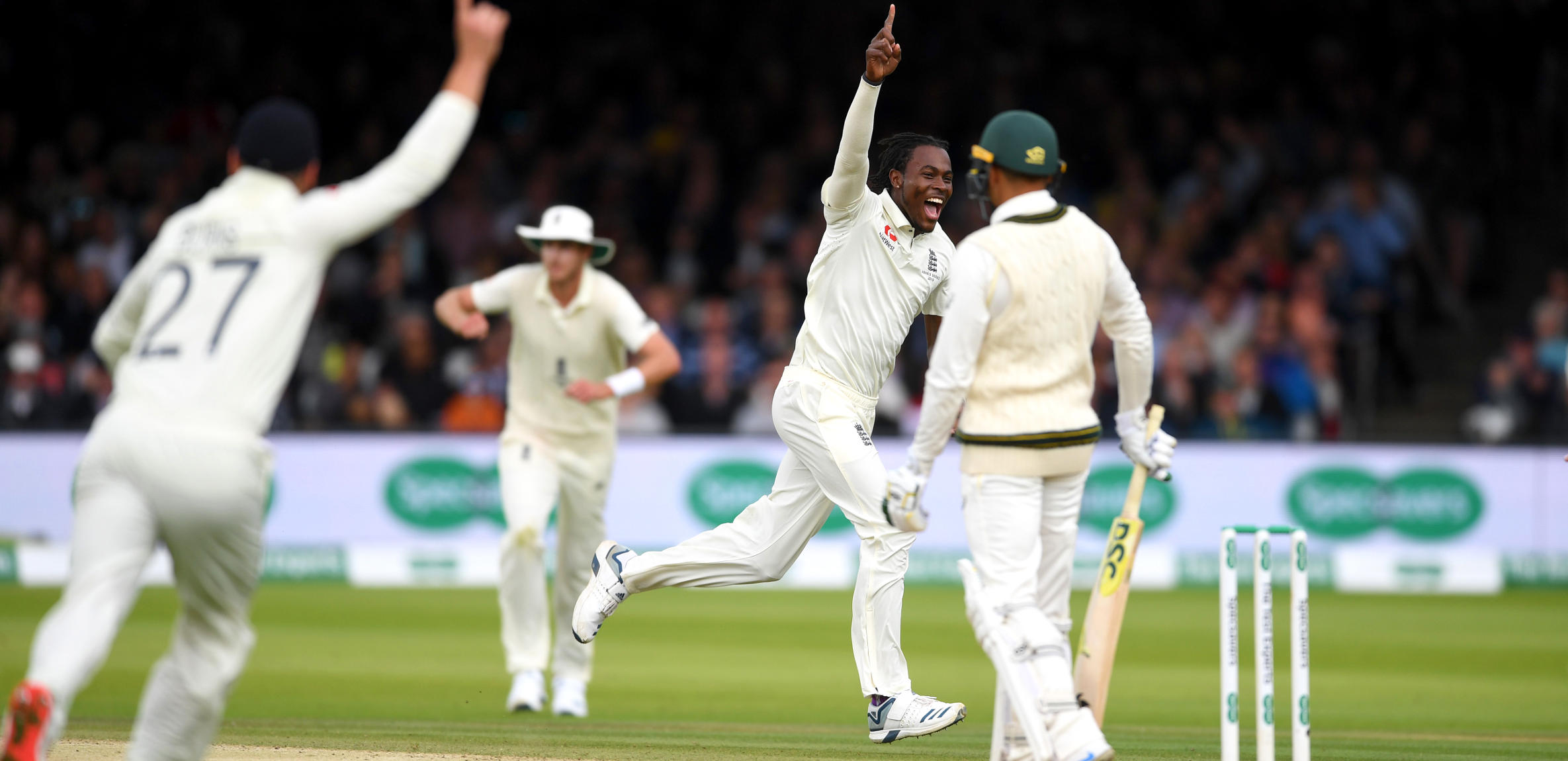
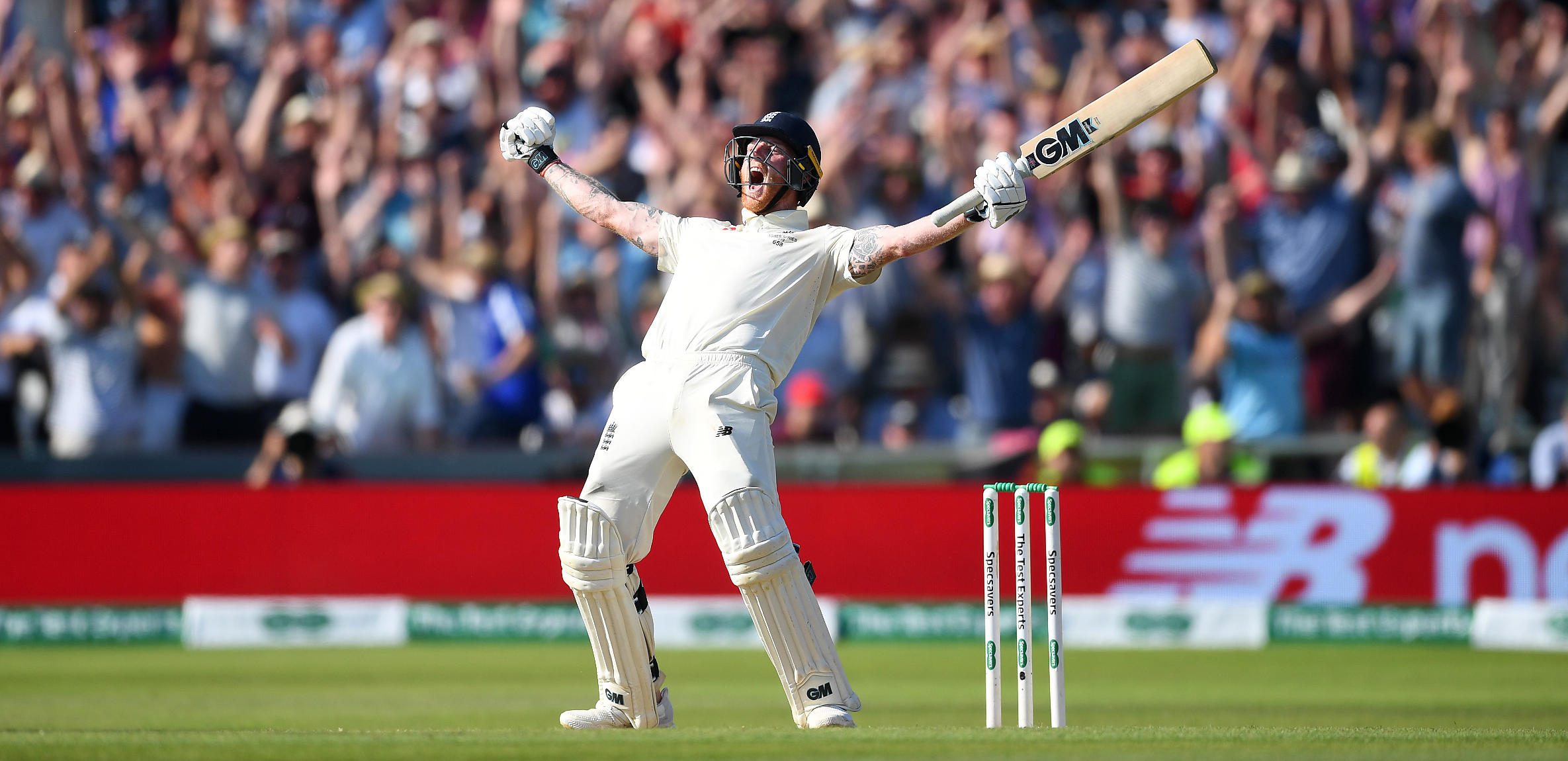

Written by Geoff Lemon
Geoff Lemon is a writer and radio broadcaster on sport, politics and literature. He’s on Twitter @GeoffLemonSport.
Design and editing by Daniel Jeffrey
Image Credit: All images are Copyright Getty Images.




























































































